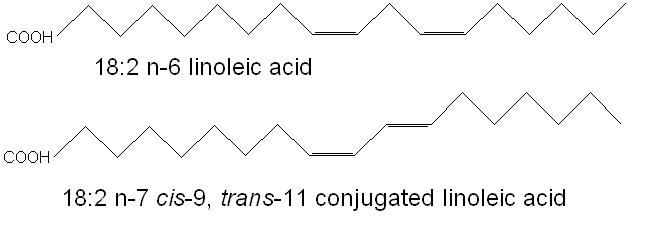Conjugated linoleic acid (CLA) is a group of isomers of the essential fatty acid fatty acid linoleic acid that are formed almost exclusively in the stomachs of ruminant animals (e.g. cattle, sheep, goats and antelopes). The cis-9, trans-11 form of CLA is also called alpha-rumenic aid because of its association with ruminants (figure 1). Feeding ruminants high grass diets rather than grain, increases the CLA content of their fatty acids. This is because the grass contains soluble fibres and fermentable sugars that provides a high pH in the rumen, and this improves the growth of the microbial populations necessary for CLA production. Humans can also synthesise CLA from the naturally occurring trans-vaccenic acid, which is also found in ruminant fats. Since the discovery of CLA around 25 years ago research has identified a number of benefits including weight control, cancer and cardiovascular disease prevention.
 Figure 1. The structures of the essential fatty acid linoleic acid (top) and the cis-9, trans-11 (alpha rumenic acid) form of conjugated linoleic acid (bottom)
Figure 1. The structures of the essential fatty acid linoleic acid (top) and the cis-9, trans-11 (alpha rumenic acid) form of conjugated linoleic acid (bottom)
Research published in the American Journal of Clinical Nutrition in 20101 investigated the associations between CLA adipose tissue concentration and the risk of myocardial infarction. To do this they measured the cis-9, trans-12 CLA content of the adipose tissue of 3626 Costa Rican individuals, some of which had survived a myocardial infarction, as well as individuals pair matched for age, sex and place of residence. The results showed that the CLA values in adipose tissue ranged from 0.35 % of fatty acids in the lowest quartile to 0.78 % in the highest quartile. Higher amounts of adipose tissue cis-9, trans-11 CLA were associated with a decreased risk of myocardial infarction. The results also showed that dairy products were not associated with a risk for myocardial infarction. The Costa Rican dairy industry uses mainly grass fed cows with a high CLA content to their fatty acids.
The benefits of CLA are well researched and the results from this study support the findings of previous researchers. The results are interesting in that dairy product consumption was not associated with myocardial infarction risk. This is more evidence that the diet heart hypothesis, which theorises that saturated fat intake is the cause of heart disease, is incorrect. The CLA contained within dairy products appears to be protective of myocardial infarction, which may be due to the anti-inflammatory effects of CLA as suggested in animal models. However, this study was retrospective and so no causal effects cannot be studied and there may be confounding variables that bias the result. Most people attain their CLA intakes from milk, but it is also present in other dairy products and ruminant meat. In addition, various isomers of CLA is also available in supplements.
RdB
